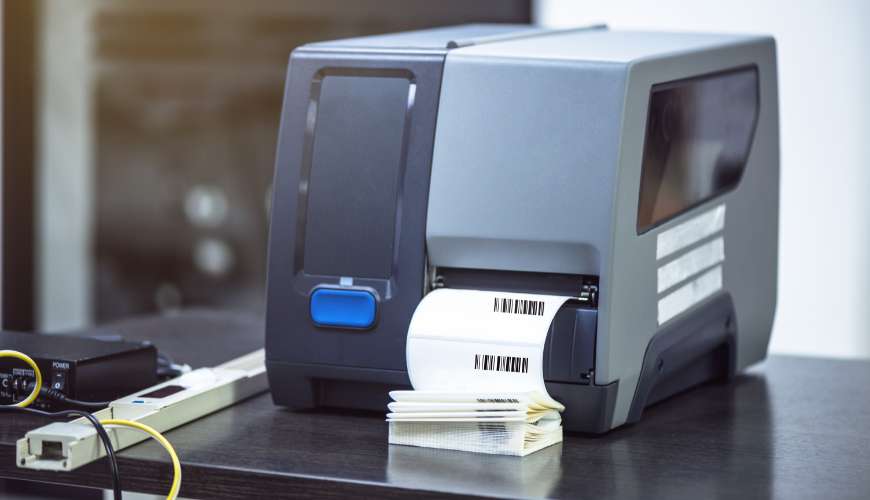When it comes to roll labels, there are two popular methods for printing: thermal transfer and direct thermal. Because both produce accurate, high-quality images with excellent edge definition, either is suitable for barcode label printing. But each has its own advantages and disadvantages, making it challenging to choose the right one for your business. Deciding between thermal transfer vs. direct thermal shipping labels can be tough.
This article will examine the difference between thermal transfer and direct thermal printing and help you decide which method is best suited to your specific needs.
Jump To Section
- What Are Thermal Transfer Labels?
- What Are Direct Thermal Labels?
- How Are Thermal Transfer Labels Printed?
- How Are Direct Thermal Labels Printed?
- What Are the Advantages of Thermal Transfer Labels?
- What Are the Advantages of Direct Thermal Labels?
- What Are the Limitations of Thermal Transfer Labels?
- What Are the Limitations of Direct Thermal Labels?
- What Are the Applications for Thermal Transfer Labels?
- What Are the Applications for Direct Thermal Labels?
- Recap: Thermal Transfer vs. Direct Thermal
- Thermal Transfer vs. Direct Thermal: Which Is Right for You?
What Are Thermal Transfer Labels?
Thermal transfer labels are printed with a heated ribbon. They can be made of various materials, including polyester, paper and polypropylene.
What Are Direct Thermal Labels?
Unlike thermal transfer labels, direct thermal labels do not need a ribbon to transfer ink or resin onto the label material. Instead, they use chemically treated, heat-sensitive media.
How Are Thermal Transfer Labels Printed?
Thermal transfer labels are printed using a specialized printer that applies heat to a ribbon to transfer ink or resin onto the label material. The label absorbs the ink, so the image becomes part of the media. Thermal transfer labels can be customized with different coatings, adhesives and sizes to meet specific requirements. The user must carefully match the ribbon to the label material to ensure durability and print performance.
How Are Direct Thermal Labels Printed?
Direct thermal labels are printed using heat to cause the image to appear directly on the heat-sensitive label. They’re available in a wide range of sizes, and direct thermal printers have no toner, ink or ribbon, making them simple and less expensive to operate.

What Are the Advantages of Thermal Transfer Labels?
Durability is the main advantage of thermal transfer labels. Because the image becomes part of the media, thermal transfer labels have superior abrasion resistance. They’re unlikely to smudge, fade or scratch. Thermal transfer labels are also highly resistant to:
- Heat
- Chemicals
- Moisture
Another advantage of thermal transfer labels is their crisp, high-definition text and graphics. They offer long image life, and the process allows single-label and batch printing with practically no waste. Thermal transfer printers generally cost less to maintain and are more durable than dot matrix or laser printers.
What Are the Advantages of Direct Thermal Labels?
Direct thermal labels provide quality, sharp images that are easy to scan. The simplicity of operating a direct thermal printer is another principal advantage, as is its low maintenance costs. Like thermal transfer printing, direct thermal printing efficiently manages single-label or batch printing, and direct thermal printers are more durable than laser or dot matrix printers.
Because direct thermal printers have fewer parts to wear or break down, they usually involve less downtime. Since there aren’t ribbons to spend time replacing, they also offer more uptime and greater production efficiency.
Direct thermal printers are compact and ideal for mobile, on-the-go labeling.
What Are the Limitations of Thermal Transfer Labels?
The need to match the right ribbon to your label material is a distinct disadvantage of thermal transfer labels. The ribbon could melt if they’re incompatible, leading to internal printer problems.
Other disadvantages include the fact that ribbons aren’t recyclable. There’s also a lot of ribbon waste if there’s not much printed on a thermal transfer label.
Because the ribbons contain an imprint of the printed information, they aren’t suitable for applications that require privacy, as in healthcare settings.
What Are the Limitations of Direct Thermal Labels?
The primary disadvantage of direct thermal labels is their sensitivity to environmental conditions like sunlight, fluorescent light, heat, moisture and chemicals. These factors can darken direct thermal labels even after printing. The labels also can fade over time. They’re not as durable as thermal transfer labels, so direct thermal labels have a shorter lifespan.
Another issue is that the direct thermal printheads see more wear and tear because they directly contact the label material. But Premium Label Supply labels include a top-coated direct thermal material to help maximize printhead lifespan.
What Are the Applications for Thermal Transfer Labels?
Thermal transfer labels are ideal for applications that require durability, including labeling for:
- Product identification
- Sample and file tracking
- Asset tagging
- Inventory identification
- Certification
- Laboratory specimens
- Freezers and cold storage
- Outdoor uses
What Are the Applications for Direct Thermal Labels?
Direct thermal labels are great for applications requiring short-term labeling, such as shipping labels. Other applications include:
- Labels for perishable goods
- Patient and visitor identification
- Pick tickets
- Receipts
Since there’s no ribbon to record information, direct thermal labels are also the go-to choice for applications that require privacy, such as prescription labels.
Recap: Thermal Transfer vs. Direct Thermal
Thermal transfer printing requires a ribbon to print thermal transfer labels, which offer advantages like durability and resistance to fading and smudging. Disadvantages include excess waste and the lack of recyclability. Applications for thermal transfer labels include asset tagging and product and inventory identification.
Direct thermal printing, on the other hand, requires no ribbon, so there’s less downtime and lower maintenance costs. But direct thermal labels aren’t as durable as thermal transfer labels. Still, they’re ideal for short-term labeling applications, like for perishable goods or shipping.
Thermal Transfer vs. Direct Thermal: Which Is Right for You?
Thermal transfer labels and direct thermal labels both have their appropriate uses. When choosing between the two, you’ll want to consider a wide range of factors, including:
- Overall costs
- Recyclability
- Durability
- Privacy requirements
- Label material
Ultimately, the answer to the thermal transfer vs. direct thermal debate depends on your application. If your use demands durability or resistance to harsh conditions, you’re better off with thermal transfer labels. But direct thermal labels are a cost-effective, convenient choice for short-term and mobile applications.
Purchase Direct Thermal Labels From Premium Label Supply
If you want reliable thermal printing labels, look no further. Premium Label Supply offers an extensive lineup of direct thermal labels perfect for shipping and other short-term applications. Our products include a strong general-purpose adhesive for more security, perforations between each label for added convenience and a top coat for extra protection. Premium Label Supply is the go-to choice for numerous labeling solutions. Start shopping now to see everything we have to offer.

